Parametric SurPyval Modelling¶
The parametric API is essentially the exact same as the non-parametric API. All models are fit by a
call to the fit() method. However, the parametric models have more options that are only applicable to parametric modelling. The inputs of x for the random variable, c for the censoring flag, n
for count of each x, xl and xr for intervally censored data (can’t be used with x) t
for the truncation matrix, tl for the left truncation scalar or array, and tr for the right truncation scalar or array all remain.
Complete Data¶
The easiest and simplest case is that when you have a dataset of exactly observed data. that is,
you have one array of data with the values at which they failed. Fitting a parametric distribution
to the data can be done with a simple call to the fit() method:
import surpyval as surv
import numpy as np
np.random.seed(10)
x = surv.Weibull.random(50, 30., 9.)
model = surv.Weibull.fit(x)
print(model)
model.plot();
Parametric SurPyval Model
=========================
Distribution : Weibull
Fitted by : MLE
Parameters :
alpha: 29.805137406871953
beta: 10.296037991991037
To visualise the outcome of this fit we can inspect the results on a probability plot:
model.plot()
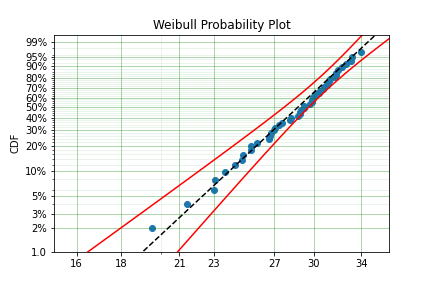
The model object from the above example can be used to calculate the density of the distribution with the parameters found with the best fit from above. This is very easy to do:
x = np.linspace(10, 50, 1000)
f = model.df(x)
plt.plot(x, f)
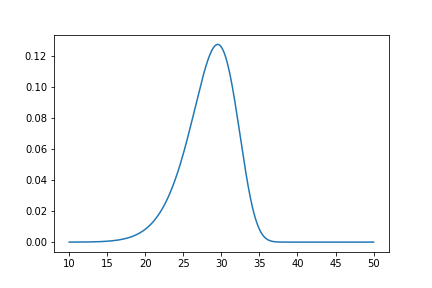
The CDF ff(), Survival (or Reliability) sf(), hazard rate hf(), or cumulative hazard rate Hf() can be computed as well. This functionality makes it very easy to work with surpyval models to determine risks or to pass the function to other libraries to find optimal trade-offs.
Using censored data¶
Right Censored¶
A common complication in survival analysis is that all the data is not observed up to the point of failure (or death). In this case the data is right censored, see the types of data section for a more detailed discussion, surpyval offers a very clean and easy way to model this. First, let’s create a simulated data set:
import surpyval as surv
import numpy as np
np.random.seed(10)
x = surv.Weibull.random(50, 30, 2.)
observation_limit = 40
# Censoring flag
c = (x >= observation_limit).astype(int)
x[x >= observation_limit] = observation_limit
In this example, we created 50 random Weibull distributed values with alpha = 30 and beta = 2. For this example the observation window has been set to 40. This value is where we stopped observing the events. For all the randomly generated values that are above this limit we create the censoring flag array c. This array has zeros where the event time was observed, and a 1 where the value is above the recorded value. For all the values in the data that are above 40 we set them to 40. This is a common occurence in survival analysis and surpyval is designed to accept this input with a simple call:
model = surv.Weibull.fit(x, c)
print(model)
model.plot()
Parametric SurPyval Model
=========================
Distribution : Weibull
Fitted by : MLE
Parameters :
alpha: 29.249243175049152
beta: 2.2291485877426354
The plot for this can be seen to be:
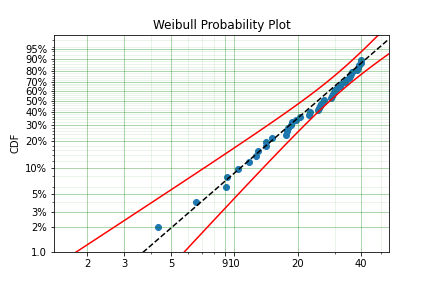
The results from this model are very close to the data we input, and with only 50 samples.
Left Censored¶
The above example can be extended to another kind of censoring; left censored data. This is the case where the values are known to fall below a particular value. We can change our example data set to have a start observation time for which we will left censor all the data below that:
observation_start = 10
# Censoring flag
c[x <= observation_start] = -1
x[x <= observation_start] = observation_start
That is, we set the start of the observations at 10 and flag that all the values at or below this are left censored. We can then use the updated values of x and c:
model = surv.Weibull.fit(x, c)
print(model)
model.plot()
Parametric SurPyval Model
=========================
Distribution : Weibull
Fitted by : MLE
Parameters :
alpha: 29.34709766238127
beta: 2.3049027909575903
The values did not substantially change, although the plot does look different as there are no values below 10.
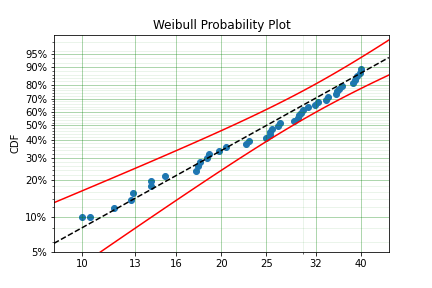
Intervally Censored¶
The next type of censoring that is naturally handled by surpyval is interval censoring. Creating another example data set:
import surpyval as surv
import numpy as np
np.random.seed(30)
x = surv.Weibull.random(50, 30, 10.)
n, xx = np.histogram(x, bins=[20, 23, 26, 29, 32, 35, 38])
x = np.vstack([xx[0:-1], xx[1:]]).T
In this example we have created the varable x with a matrix of the intervals within which each of the obervations have failed. That is each exact observation has been binned into a window and the x array has an entry [left, right] within which the event failed. We also have the n array that has the count of the failures within the window. With these two values we can make the simple surpyval call:
model = surv.Weibull.fit(x, n=n)
print(model)
Parametric SurPyval Model
=========================
Distribution : Weibull
Fitted by : MLE
Parameters :
alpha: 30.074154903683105
beta: 9.637405285678362
Again, we have a result that is very close to the original parameters. SurPyval can take as input an arbitrary combination of censored data. If we plot the data we will see:
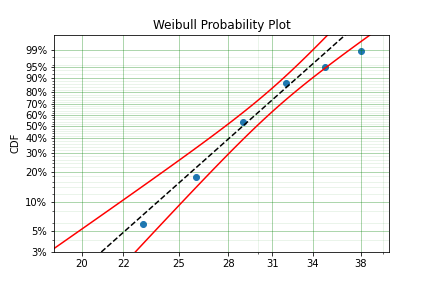
This is a good fit! The data at the tails are a little bit off, but this is only 50 samples and the core of the model matches the data quite well.
Mixed Censoring¶
Mixed censoring, or arbitrary censoring is easily handled by SurPyval. So no matter the combination of the data that you have, SurPyval will be able to fit a distribution to it.
import surpyval as surv
x = [0, 1, 2, [3, 4], [6, 10], [4, 8], 5, 19, 10, 13, 15]
c = [0, 0, 1, 2, 2, 2, 0, -1, 0, 1, 0]
surv.Gumbel.fit(x, c=c)
Parametric SurPyval Model
=========================
Distribution : Gumbel
Fitted by : MLE
Parameters :
mu: 9.912232006272871
sigma: 4.95952392045353
Using truncated data¶
Left truncated¶
Surpyval has the capacity to handle arbitrary truncated data. A common occurence of this is in the insurance industry data. When customers make a claim on their policies they have to pay an ‘excess’ which is a charge to submit a claim for processing. If say, the excess on a set of policies in an area is $250, then it would not be logical for a customer to submit a claim for a loss of less than that number. Therefore there will be no claims under $250. This can also happen in engineering where a part may be tested up to some limit prior to be sold, therefore, as a customer you need to make sure you take into account the fact that some parts would have been rejected at the end of the line which you may not have seen. So a washing machine may run through 25 cycles prior to shipping. This is similar to, but distinct from censoring. When something is left censored, we know there was a failure or event below the threshold. Whereas with truncation, we do not see any variables below the threshold. A simulated example may explain this better:
import numpy as np
import surpyval as surv
np.random.seed(10)
x = surv.Weibull.random(100, alpha=100, beta=0.6)
# Keep only those values greater than 250
threshold = 25
x = x[x > threshold]
We have therefore simulated a scenario where we have taken 100 random samples from a fat tailed Weibull distribution. We then filter to keep only those records that are above the threshold. In this case we assume we haven’t seen the data for the washing machines with less than 25 cycles. To understand what could go wrong if we ignore this, what do we get if we assume all the data are failures and there is no truncation?
model = surv.Weibull.fit(x=x)
print(model.params)
[218.39245675 1.0507186 ]
With a plot that looks like:
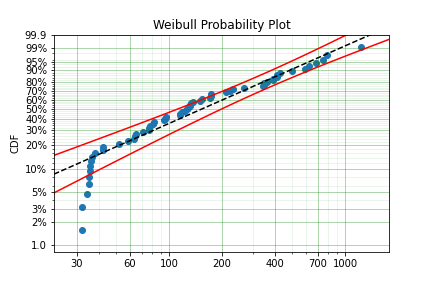
Looking at the parameters of the distribution, you can see that the beta value is greater than 1. Although only slightly, this implies that this distribution has an increasing hazard rate. If you were the operator of the washing machines (e.g. a hotel or a laundromat) and any downtime had a cost, you would conclude from this that replacing the machines after a fixed time would be a good policy.
But if you take the truncation into account:
model = surv.Weibull.fit(x=x, tl=threshold)
print(model.params)
[127.32704868 0.71053572]
With the plot:
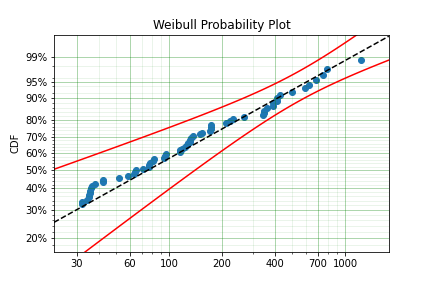
You can see now that the model fits the data much better, but also that the beta parameter is actually below 1. This shows that ignoring the left-truncated data in parametric estimation can lead to errors in prediction.
Right truncated¶
The example from above can be continued for right-truncated data as well.
import numpy as np
import surpyval as surv
np.random.seed(10)
x = surv.Normal.random(100, mu=100, sigma=10)
# Keep only those values greater than 250
tl = 85
tr = 115
# Truncate the data
x = x[(x > tl) & (x < tr)]
model = surv.Weibull.fit(x=x, tl=tl, tr=tr)
print(model.params)
[102.27078401 12.47906136]
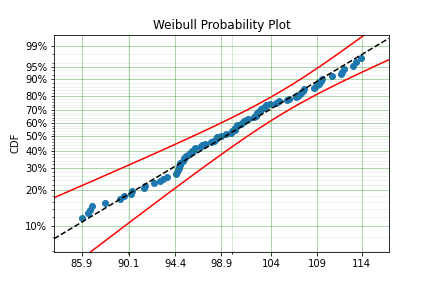
From the output above, the number of data points we have has been reduced from the simulated 100, downt to 87. Then with the 87 samples we now have we estimated the parameters to be quite close to the parameters used in the simulation. Further, the plot looks as though the parametric distribution fits the non-parametric distribution quite well.
In the cases above we used a scalar value for the truncation values. But some data has individual values for left truncation. This is seen in trials where someone may join the trial as a late entry. Therefore each data point as an entry time. For example:
import surpyval as surv
x = [3, 4, 6, 7, 9, 10]
tl = [0, 0, 0, 0, 5, 2]
model = surv.Weibull.fit(x, tl=tl)
print(model.params)
[7.05854717 2.70096672]
Intervally and Arbitrarily truncated¶
Surpyval can even work with arbitrary left and right truncation:
import surpyval as surv
x = [3, 4, 6, 7, 9, 10]
tl = [0, 0, 0, 0, 5, 2]
tr = [10, 9, 8, 10, 15]
model = surv.Weibull.fit(x, tl=tl, tr=tr)
print(model.params)
[8.12377602 2.56917036]
In the above example we used both the tl and tr. However, surpyval has a flexible API where it can take the truncation data as a two dimensional array:
import surpyval as surv
x = [3, 4, 6, 7, 9, 10]
t = [[ 0, 10],
[ 0, 9],
[ 0, 8],
[ 0, 10],
[ 5, 15],
[ 2, 15]]
model = surv.Weibull.fit(x, t=t)
print(model.params)
[8.12377602 2.56917036]
Which, obviously, gives the same result. This shows the flexibility of the surpyval API, you can use scalar, array, or matrix values for the truncations using the t, tl, and tr keywords with the fit method and surpyval does the rest.
Offsets¶
Another common feature in survival analysis is a requirement to fit a distribution with an offset. These distributions are sometimes referred to as the two-parameter (e.g. two parameter exponential) three parameter, (e.g., the three three parameter Weibull), or four parameter (e.g four parameter Exponentiated Weibull distribution). SurPyval however just uses an offset to increase the numbers of parameters and allow the distribution to be shifted.
Using data from Weibull’s original paper for the strenght of Bofor’s steel shows when this might be necessary.
import surpyval as surv
from surpyval.datasets import BoforsSteel
df = BoforsSteel.df
x = df['x']
n = df['n']
model = surv.Weibull.fit(x=x, n=n)
print(model.params)
model.plot()
[47.36735846 17.5713195 ]
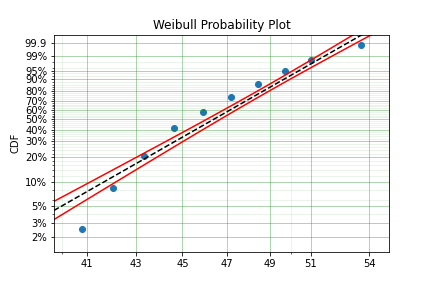
The above plot does not look to be a good fit. However, if we use an offset we can use the three parameter Weibull distribution to attempt to get a better fit. Using offset values with surpyval is very easy:
import surpyval as surv
from surpyval.datasets import BoforsSteel
df = BoforsSteel.df
x = df['x']
n = df['n']
model = surv.Weibull.fit(x=x, n=n, offset=True)
print(model)
model.plot()
Parametric SurPyval Model
=========================
Distribution : Weibull
Fitted by : MLE
Offset (gamma) : 39.76562962867477
Parameters :
alpha: 7.141925216146524
beta: 2.6204524040137844
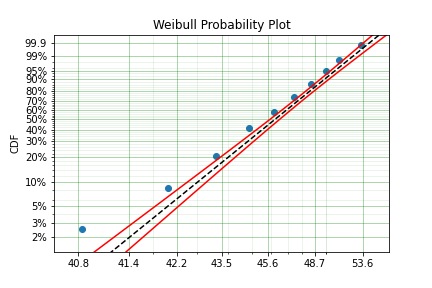
This is evidently a much better fit! The offset value for an offset distribution is saved as gamma in the model object. Offsets can be used for any distribution supported on the half real line. Currently, this is the Weibull, Gamma, LogNormal, LogLogistic, and Exponential. For example:
import surpyval as surv
import numpy as np
np.random.seed(10)
x = surv.LogLogistic.random(100, 10, 3) + 10
model = surv.LogLogistic.fit(x, offset=True, how='MLE')
print(model)
model.plot()
Parametric SurPyval Model
=========================
Distribution : LogLogistic
Fitted by : MLE
Offset (gamma) : 9.56270794050046
Parameters :
alpha: 10.18946967467503
beta: 3.407325975660712
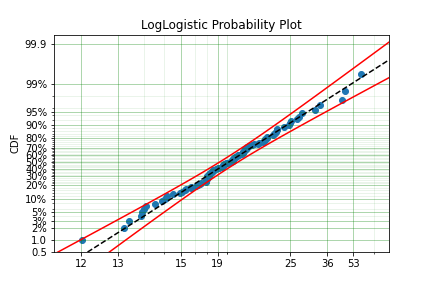
A four parameter exponentiated Weibull can also be found:
import surpyval as surv
import numpy as np
np.random.seed(10)
x = surv.ExpoWeibull.random(100, 10, 1.2, 4) + 10
model = surv.ExpoWeibull.fit(x, offset=True)
print(model)
model.plot(plot_bounds=False)
Parametric SurPyval Model
=========================
Distribution : ExpoWeibull
Fitted by : MLE
Offset (gamma) : 10.701280166551431
Parameters :
alpha: 11.47511146192537
beta: 1.3969785125819283
mu: 2.845307244239084
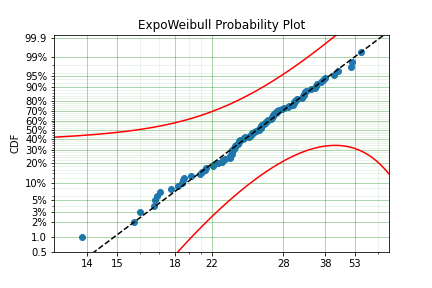
Fixing parameters¶
Another useful feature of surpyval is the ability to easily fix parameters. For example:
import surpyval as surv
import numpy as np
np.random.seed(30)
x = surv.Normal.random(50, 10., 2)
model = surv.Normal.fit(x, fixed={'mu' : 10})
print(model)
model.plot()
Parametric SurPyval Model
=========================
Distribution : Normal
Fitted by : MLE
Parameters :
mu: 10.0
sigma: 1.9353643871136006
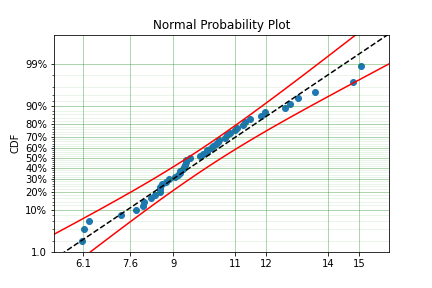
You can see that the mu parameter has been fixed at 10. This can work for distribuitons with many more parameters, including the offset.
import surpyval as surv
import numpy as np
np.random.seed(30)
x = surv.ExpoWeibull.random(50, 10., 2, 4) + 10
model = surv.ExpoWeibull.fit(x, offset=True, fixed={'mu' : 4, 'gamma' : 10, 'alpha' : 10})
print(model)
model.plot()
Parametric SurPyval Model
=========================
Distribution : ExpoWeibull
Fitted by : MLE
Offset (gamma) : 10.0
Parameters :
alpha: 10.0
beta: 1.9986073390210994
mu: 1.2
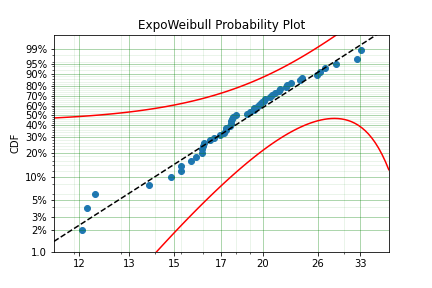
We have fit three of the four parameters for an offset exponentiated-Weibull distribution!
Modelling with arbitrary input¶
The surpyval API is extremely flexible. All the unique examples provided above can all be used at once. That is, data can be censored, truncated, and directly observed with offsets and fixing parameters. The API is completely flexible. This makes surpyval an extremely useful tool for analysts where the data is gathered in a manner where it’s cleanliness is not guaranteed.
import surpyval as surv
x = [0, 1, 2, [3, 4], [6, 10], [4, 8], 5, 19, 10, 13, 15]
c = [0, 0, 1, 2, 2, 2, 0, -1, 0, 1, 0]
tl = [-1, 0, 0, 0, 0, 0, 2, 2, -np.inf, 0, 0]
tr = 25
model = surv.Normal.fit(x, c=c, tl=tl, tr=tr, fixed={'mu' : 1.})
print(model)
Parametric SurPyval Model
=========================
Distribution : Normal
Fitted by : MLE
Parameters :
mu: 1.0
sigma: 9.131202240846182
Using alternate estimation methods¶
Surpyval’s API is very flexible because you can change which method is used to estimate parameters. This is useful when a more appropriate method is needed or the method you are using fails.
The default parametric method for surpyval is the maximum likelihood estimation (MLE), this is because it can take any arbitrary input. However, the MLE is not always the best estimator. Consider an example with the uniform distribution:
import surpyval as surv
import numpy as np
np.random.seed(5)
x = surv.Uniform.random(20, 5, 10)
print(x.min(), x.max())
mle_model = surv.Uniform.fit(x)
print(*mle_model.params)
5.9386061433062585 9.593054539689607
5.9386061433062585 9.593054539689607
You can see that the results are the same. This is because the maximum likelihood estimate of the parameters of a uniform distriubtion are just the smallest and largest values in the sample. If however we use the ‘Maximum Product Spacing’ method we get:
mps_model = surv.Uniform.fit(x, how='MPS')
print(*mps_model.params)
5.532556321486052 9.999104361509815
You can see that using the MPS method we have parameters that are closer to the real values. This is because the MPS method can ‘look outside’ the existing values to estimate where the real value lies. See the details of this method in the ‘Parametric Estimation’ section. But the MPS method is useful when you need to estimate the point at which a distribution’s support starts or for any disttribution that has unknown support. Concretely, this includes any offset distribution or a distribution with a finite upper and lower support (Uniform, Generalised Beta, Triangle)
The other important use case is when, for some reason, an alternate estimation method just does not work. For example:
import surpyval as surv
import numpy as np
np.random.seed(30)
x = surv.LogLogistic.random(10, 4., 2) + 10
model = surv.LogLogistic.fit(x, how='MLE', offset=True)
Precision was lost, try:
- Using alternate fitting method
- visually checking model fit
- change data to be closer to 1.
This shows, that the Maximum Likelihood Estimation may have failed for this data. However, because we have access to other methods, we can use an alternate estimation method:
import surpyval as surv
import numpy as np
np.random.seed(30)
x = surv.LogLogistic.random(10, 4., 2) + 10
model = surv.LogLogistic.fit(x, how='MPS', offset=True)
print(model)
model.plot()
Parametric SurPyval Model
=========================
Distribution : LogLogistic
Fitted by : MPS
Offset (gamma) : 11.524905733806891
Parameters :
alpha: 2.631868521887908
beta: 0.9657662293516666
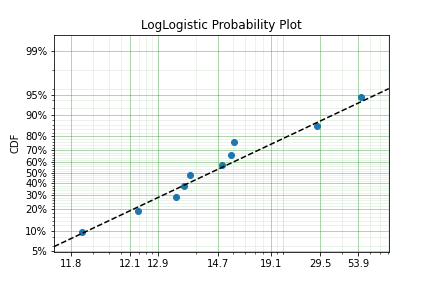
Our estimation has worked! Even though we used the MPS estimate for the parameters, we can still call all the same functions with the created variable to find the density df(), hazard hf(), CDF ff(), SF sf() etc. So regardless of the estimation method, we can still use the model.
This shows the power of the flexible API that surpyval offers, because if your modelling fails using one estimation method, you can use another. In this case, the MPS method is quite good at handling offset distributions. It is therefore a good approach to use when using offset distributions.
As stated in the Non-Parametric section, there is a risk that using the Turnbull estimator when all values are trunctated by the same values. We will now show what happens. First, some example data:
import surpyval as surv
import numpy as np
np.random.seed(1)
x = surv.Normal.random(1000, 100, 10)
tl = 90
tr = 110
x = x[x > tl]
x = x[x < tr]
mpp_model = surv.Normal.fit(x, tl=tl, tr=tr, how='MPP')
mpp_model.plot()
mpp_model
Parametric SurPyval Model
=========================
Distribution : Normal
Fitted by : MPP
Parameters :
mu: 100.03108440743388
sigma: 5.432878735738111
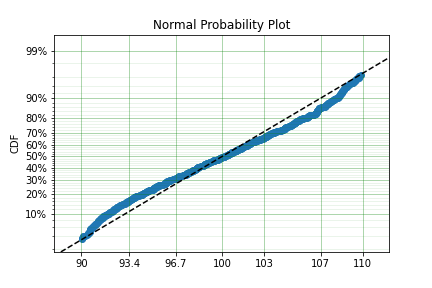
You can see that there is a strange match between the Turnbull estimate of the CDF and the parametric model. Also, you can see that the CDF at 90 is near 0% and the CDF at 110 is near 100%. This shows that it has not taken into account the truncation. Instead, if we use MLE we get:
model = surv.Normal.fit(x, tl=tl, tr=tr, how='MLE')
model.plot()
model
Parametric SurPyval Model
=========================
Distribution : Normal
Fitted by : MLE
Parameters :
mu: 100.13045397963812
sigma: 9.17784957390746
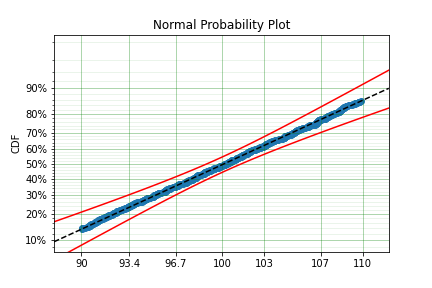
We can see that the MLE method is a much better fit to this data, further, the MLE estimate of the \(\sigma\) parameter is much closer. The plotting points for the MLE plot have been adjusted in accordance with the truncation that the MLE model has estimated at the first entry. This is because it is known to be truncated and needs to be adjusted. This is not possible with the MPP method because the Turnbull estimator cannot adjust the truncation at the first and last value as it can make no assumptions about the truncation at those points.
This is just a word of warning for when using Truncation and the MPP method, make sure not all values are truncated by the same value, otherwise it will give a poor fit.
Mixture Models¶
On occasion, it can appear as though there are one, or two different distributions in the data you are using. On these occasions it can be useful to use a different type of distribuiton; or really, distributions. A mixture model is a distribution made from the partial combination of several distributions. Intuitively, it can be understood as a distribution where there is a proportion that fail for each kind of distribution. So 60% may come from a Weibull(3, 4) distribution but then another 40% come from a Weibull(19, 2) distribution.
SurPyval uses Expectation-Maximisation to
import surpyval as surv
import numpy as np
from matplotlib import pyplot as plt
x = [1, 2, 3, 4, 5, 6, 6, 7, 8, 10, 13, 15, 16, 17 ,17, 18, 19]
x_ = np.linspace(np.min(x), np.max(x))
model = surv.Weibull.fit(x)
wmm = surv.MixtureModel(x=x, dist=surv.Weibull, m=2)
model.plot(plot_bounds=False)
plt.plot(x_, wmm.ff(x_))
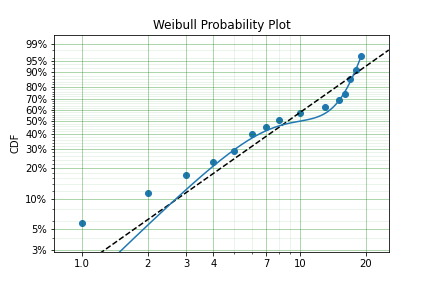
You can see that the mixture model, in blue, tracks the data more closely than does the single model. SurPyval has incredible flexibility. The number of distributions can be changed by simply changing the value of m, and, the distribution passed to dist in the mixture can also be changed. Consider:
import surpyval as surv
import numpy as np
from matplotlib import pyplot as plt
np.random.seed(1)
x1 = surv.Normal.random(20, -10, 5)
x2 = surv.Normal.random(30, 10, 10)
x3 = surv.Normal.random(40, 50, 15)
x = np.concatenate([x1, x2, x3])
np.random.shuffle(x)
x_ = np.linspace(np.min(x), np.max(x))
normal = surv.Normal.fit(x)
gmm = surv.MixtureModel(x=x, dist=surv.Normal, m=3)
normal.plot(plot_bounds=False)
plt.plot(x_, gmm.ff(x_), color='red')
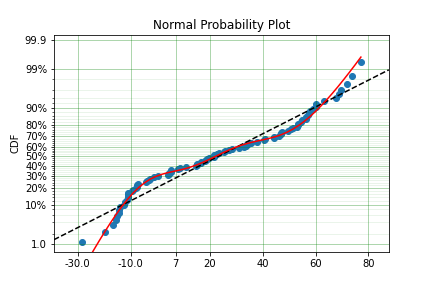
It was that simple to create a gaussian mixture model using m=3 and the dist=surv.Normal parameters. SurPuyval does default to 2 Weibull distributions if neither parameters are provided, but it can take any distribution in SurPyval as an input distribution.
Finally, mixture models can take counts and censoring flags as input (but not, yet, truncation). This makes SurPyval a truly powerful package for your survival analysis.
Limited Failure Population¶
Another kind of model that is useful in survival analysis is when a population has a limited number of items in the population that are susceptible to the failure. This is also known as a ‘Defective Subpopulation’ model. As such, no matter how long a test continues, it will not be possible for all items to fail (with the particular death/failure).
As an example, we can created a Defective Subpopulation Weibull, also known as a Limited Failure Population Model using a Weibull distribution:
import surpyval as surv
import numpy as np
from matplotlib import pyplot as plt
lfp_weibull = surv.Weibull.from_params([10, 2], p=0.6)
np.random.seed(10)
# LFP Model outputs x, c, and n from `random()`
x, c, n = lfp_weibull.random(100)
# Fit regular Weibull
model = surv.Weibull.fit(x=x, c=c, n=n)
model.plot(plot_bounds=False)
# Set LFP to be `True`
lfp_model = surv.Weibull.fit(x=x, c=c, n=n, lfp=True)
print(lfp_model)
xx = np.linspace(np.min(x), np.max(x)*2)
plt.plot(xx, lfp_model.ff(xx), color='red')
Parametric SurPyval Model
=========================
Distribution : Weibull
Fitted by : MLE
Max Proportion (p) : 0.5553951704157292
Parameters :
alpha: 10.180334244350309
beta: 2.1358575854287265
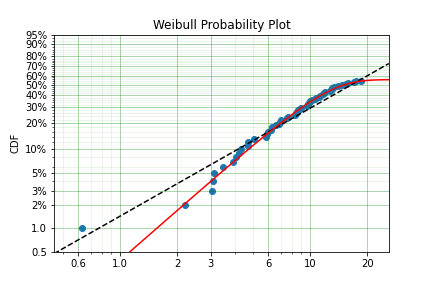
This API works with any distribution so simply changing Weibull to Exponential would create a Defective Subpopulation Exponential / Limited Failure Population Exponential model. Further, if it was changed to Gamma it would create a Defective Subpopulation Gamma model / Limited Failure Population Gamma.
LFP models can only (as yet) work with MLE. It cannot (yet) work with the other estimation methods. The MSE is a good candidate for implementation.
Zero-Inflated Modelling¶
In survival analysis you might have the scenario where many failure times are 0, known as being dead on arrival. In this case we need a model that can account for the fact that many will be failed at 0, this is a situation that cannot be handled by regular distribuitons, since most have a 0% chance of failing at 0. Therefore what we need is something that is symmetrical to the LFP/DS case, where a proportion of the failures occur at 0 instead of there being a proportion that will never fail.
import surpyval as surv
from autograd import numpy as np
dist = surv.ExpoWeibull
model = dist.from_params([10.2, 2., 1.3], f0=0.15)
np.random.seed(10)
x = model.random(100)
model
Parametric SurPyval Model
=========================
Distribution : ExpoWeibull
Fitted by : given parameters
Zero-Inflation (f0) : 0.15
Parameters :
alpha: 10.2
beta: 2.0
mu: 1.3
Using this random data, we can make a fitted model (with the added convenience not offered in the real world of knowing exactly what parameters we are aiming toward).
fitted_model = dist.fit(x, zi=True)
print(fitted_model)
fitted_model.plot()
Parametric SurPyval Model
=========================
Distribution : ExpoWeibull
Fitted by : MLE
Zero-Inflation (f0) : 0.1799999522942094
Parameters :
alpha: 11.723925167019866
beta: 2.769781748379123
mu: 0.8437868556785479
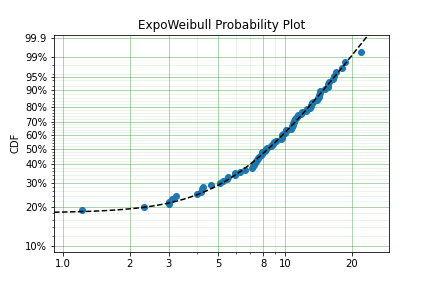
We can see that we have made a good fit!
To showcase the SurPyval API again, and to demonstrate the flexibility, it is trivial to have Defective Subpopulation Zero Inflated (DSZI) model / Limited Failure Population and Zero Inflated model.
import surpyval as surv
import numpy as np
dist = surv.LogNormal
model = dist.from_params([2.2, .2], f0=0.05, p=0.6)
np.random.seed(10)
# Random values from LFP models come in xcn format!!!!!
x, c, n = model.random(100)
fitted_model = dist.fit(x, c, n, zi=True, lfp=True)
print(fitted_model)
fitted_model.plot()
Parametric SurPyval Model
=========================
Distribution : LogNormal
Fitted by : MLE
Max Proportion (p) : 0.6061204729747632
Zero-Inflation (f0) : 0.040000034963115105
Parameters :
mu: 2.2060270833195372
sigma: 0.19060910628572927
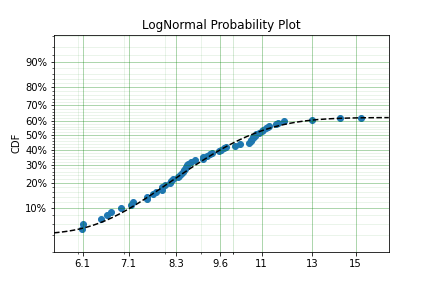
Using a LogNormal distribution we were able to easily capture the DS/LFP and ZI behaviour of the data.
Confidence Intervals¶
SurPyval can be used to compute the confidence interval for any of the functions of a distribution. That is, SurPyval can
compute the confidence interval for ff(), sf(), hf(), Hf(), and df().
Once you have a model, this can easily be computed with the cb() method.
from surpyval import Weibull
import numpy as np
from matplotlib import pyplot as plt
x = Weibull.random(100, 10, 3)
model = Weibull.fit(x)
x_plot = np.linspace(0, 20, 100)
plt.plot(x_plot, model.sf(x_plot), color='black')
plt.plot(x_plot, model.cb(x_plot, on='sf', alpha_ci=0.1), color='red', linestyle='--')
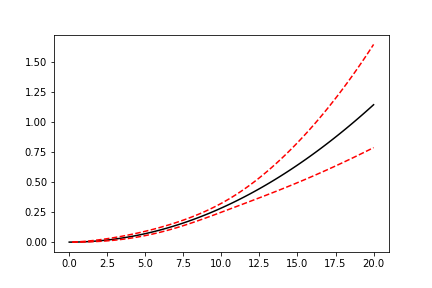
This shows that we can change the confidence level with alpha_ci and that we can change the function for which
we want the confidence interval. That is, the on keyword can be any of sf, ff, df, hf, or Hf.
This will work with models that you create as well, so even a user defined Distribution will be able to have the
confidence intervals computed. Creating these models is discussed in the section below.
Creating a custom Distribution¶
Given the implementation in SurPyval, it is possible to create a new distribution and use all the previously listed techniques. For example, the Gompertz distribution is not implemented in the surpyval API, this however can be quickly overcome. First, we set up a random number generator. Because SurPyval works based on the autograd numpy implementation, it is essential that you use the autograd numpy import to make this work.
import surpyval as surv
# IMPORTANT - Will not work with regular numpy
from autograd import numpy as np
def qf(p, mu, b):
return (np.log(((-np.log(p)/mu))) + 1)/b
# Generate random values from Gompertz distribution
np.random.seed(1)
x = qf(np.random.uniform(0, 1, 100), .3, 1.1)
Now that we have our random data set, we can fit a Gompertz distribution to it. To do so, we need to create a Gompertz distribution class, and to do this we need the cumulative hazard function, the names of the parameters, the bounds of the parameters, and the distribution support.
name = 'Gompertz'
def Hf(x, *params):
return params[0] * np.exp(params[1] * x - 1)
param_names = ['nu', 'b']
bounds = ((0, None), (0, None))
support = (-np.inf, np.inf)
Gompertz = surv.parametric.Distribution(name, Hf, param_names, bounds, support)
With this now created, all the calls to the regular surpyval API can be used.
Gompertz.fit(x)
Parametric SurPyval Model
=========================
Distribution : Gompertz
Fitted by : MLE
Parameters :
nu: 1.15060014910275
b: 1.8973107004872167
If we transform the data slightly, we can show that this can be used with censored and truncated data as well.
c = np.zeros_like(x)
# Right censor all values above 2
c[x > 2] = 1
x[x > 2] = 2
# Left truncate all values below 0
tl = 0
c = c[x > tl]
x = x[x > tl]
model = Gompertz.fit(x=x, c=c, tl=tl)
model
Parametric SurPyval Model
=========================
Distribution : Gompertz
Fitted by : MLE
Parameters :
nu: 1.4228615499353794
b: 1.688152800158132
This is extraordinary! We have created a new distribution using only the cumulative hazard function, but are able to handle arbitrary censoring and truncation. It shows the power of the SurPyval API and functionality.
Credit for this idea must be given to the creators of the lifelines package. lifelines is capable of receiving a cumulative hazard function that can then be used as a distribution to fit parameters. However, at the time of writing it could not handle arbitrarily censored or truncated data.
Even with a user defined Hf() we can still use the confidence bounds as well. The results of this
can be seen by simply calling the plot function:
model.plot(alpha_ci=0.5)
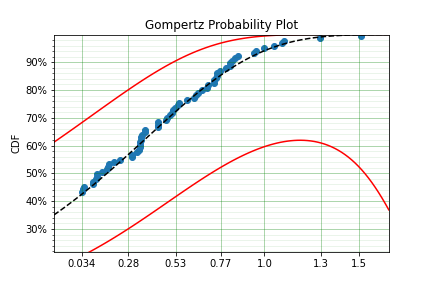
You can see that the distribution is not linearised. This is because the Hf is not readily convertible into the transformation function needed to do the linearisation of the CDF. The defaults are a simple linear scale for both the x and y axis and it shows that the confidence bounds have worked nicely.
You can also see that the confidence bound expands quite widely above approximately 1.2. This is due to the heavy truncation and censoring, if using complete data the confidence boudns do not diverge. This shows the importance of inference when working with truncated and censored data, the uncertainty can be quite wide!
Warning
Due to the implementation of confidence bounds in surpyval it can result in numeric overflows which results in incredulous bounds. Please take caution when using the cb with non surpyval implemented distributions.